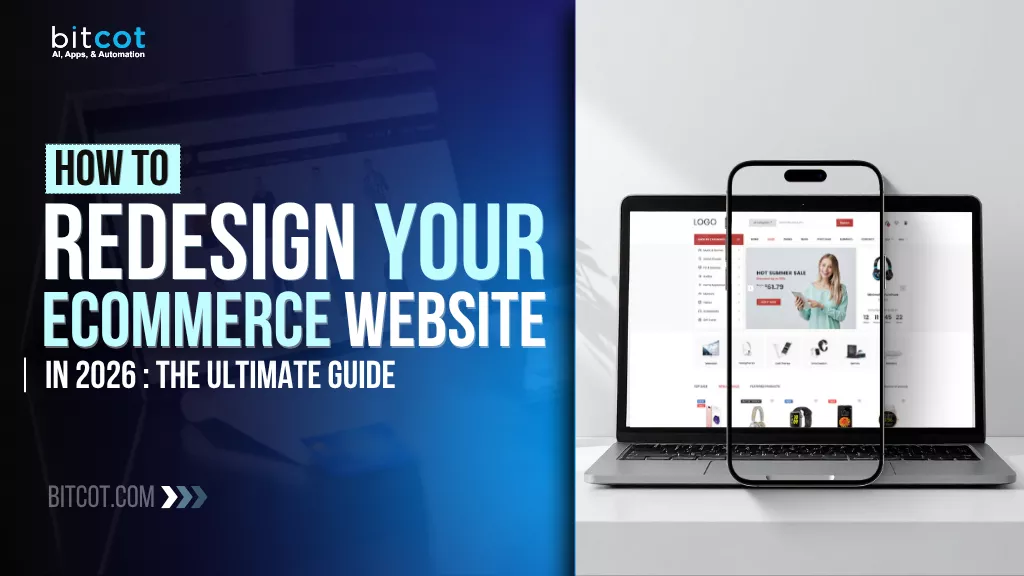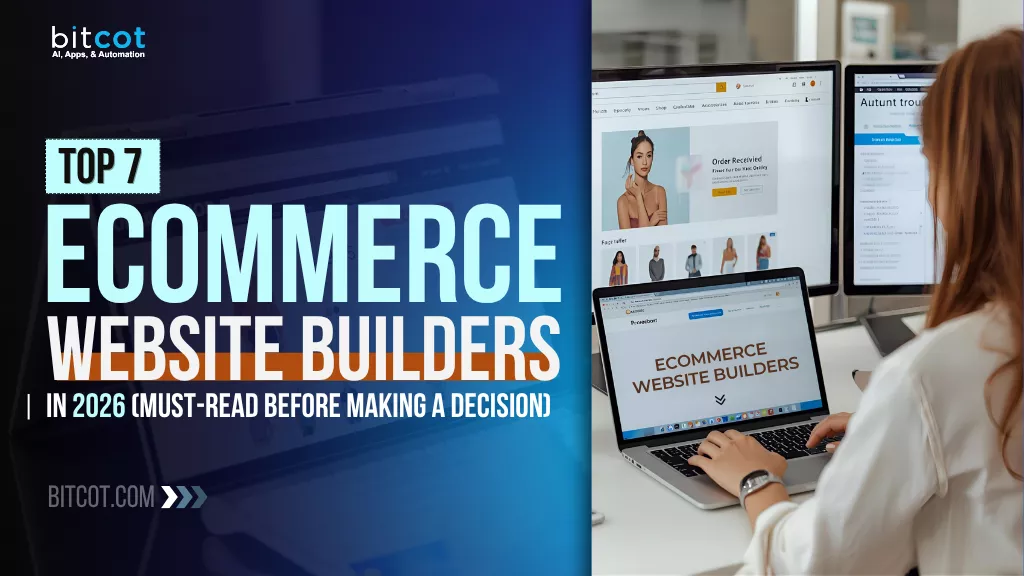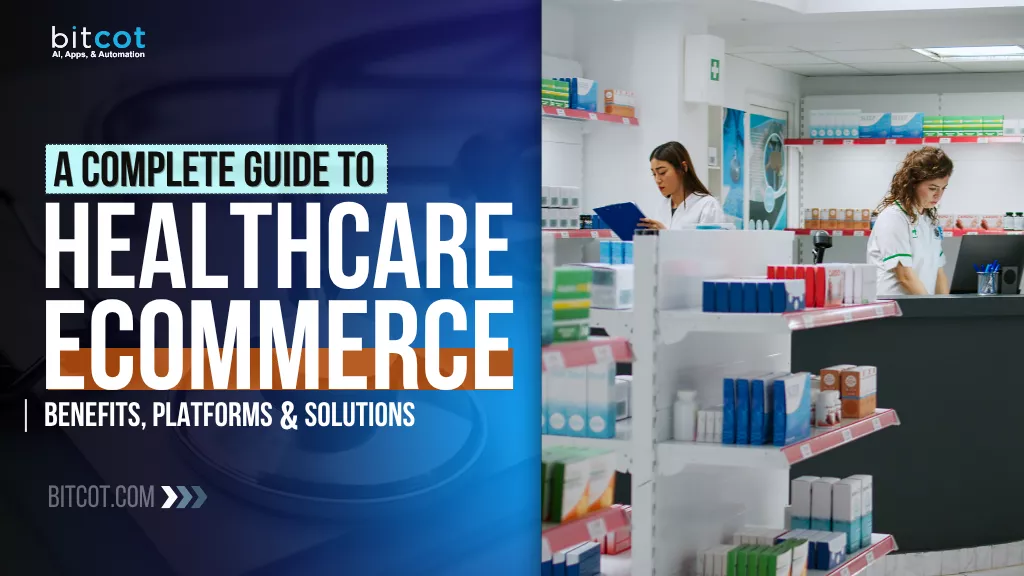
Healthcare today is no longer limited to clinic walls. Patients jump between websites, apps, marketplaces, and even social media, expecting fast information, easy ordering, and reliable delivery; no delays, no confusion.
But when your eCommerce systems don’t speak to each other, every interaction becomes fragmented. Your team scrambles through spreadsheets and disconnected tools, and patients lose confidence in the process.
Sound familiar?
Modern healthcare consumers expect smooth, transparent, 24/7 digital experiences, just like any other online shopping journey. When you can’t provide that, you risk losing sales, negative reviews, and declining patient satisfaction.
In this guide, we break down everything you need to build a powerful healthcare eCommerce ecosystem, from choosing the right platforms to implementing secure payment systems, managing compliance, optimizing fulfillment, and delivering seamless patient experiences.
You’ll get real examples, key platform comparisons, and practical solutions you can start using immediately.
Ask yourself:
- How many orders get delayed because of manual processing?
- How often do patients have to call back for updates?
- How much time does your team spend re-entering or correcting data?
You already know the challenges. But how close are you to solving them?
Whether you run a pharmacy, clinic, healthcare brand, or digital health startup, the shift is happening fast. Every friction point in the buying experience means lost revenue and lost trust.
Healthcare eCommerce platforms are eliminating those gaps. They streamline sales, automate workflows, ensure compliance, and create connected, patient-friendly digital storefronts.
Bitcot helps you make that transformation. We build intelligent, compliant eCommerce solutions for healthcare industry use cases that simplify operations, boost conversions, and improve patient care.
The future of digital healthcare is already here. The question is, are you ready to deliver it?
What is Healthcare eCommerce and Why Does It Matter?
Healthcare eCommerce is the buying and selling of medical products and services online. It covers a wide range of items, from prescription medications and over-the-counter health supplements to medical equipment and healthcare consultations.
Essentially, it’s the intersection of healthcare and digital commerce, making it easier for people to access the products and services they need without leaving their homes.
But why does healthcare eCommerce matter so much?
First off, it has made healthcare more accessible. Whether it’s a patient ordering a blood pressure monitor or a person looking for wellness products, eCommerce has created a more convenient way to shop for health-related items. You no longer have to visit a physical store or wait in long lines at the pharmacy.
This is especially important for people who live in rural areas, have mobility issues, or simply prefer the convenience of online shopping.
Another big reason healthcare eCommerce matters is the rising demand for personalized care. Many eCommerce platforms allow customers to consult with healthcare professionals remotely. Whether it’s a virtual doctor’s visit or an online consultation for skincare or nutrition, these services help people receive tailored advice in a more cost-effective and time-efficient way.
Healthcare eCommerce also plays a crucial role in streamlining supply chains, especially during times of crisis, like the COVID-19 pandemic. It helps ensure that medical products, such as PPE, vaccines, and critical supplies, are quickly distributed and available to those who need them.
In short, eCommerce for healthcare is transforming the industry by making essential products and services more accessible, affordable, and efficient. As we continue to rely more on technology, it’s safe to say that healthcare eCommerce is only going to grow in importance.
Benefits of Healthcare eCommerce
The rise of eCommerce for healthcare industry use cases brings a lot of advantages to both consumers and businesses alike.
Here are some key benefits that make this trend such a game-changer in the healthcare space:
1. Convenience and Accessibility
One of the biggest benefits of eCommerce in healthcare is the sheer convenience it offers. People can shop for healthcare products, schedule appointments, or even consult with doctors, all from the comfort of their own homes. This is especially beneficial for individuals who have busy schedules, limited access to healthcare facilities, or mobility issues.
2. Lower Costs
Healthcare eCommerce can also help reduce costs. Traditional healthcare services often come with additional expenses like transportation, time off work, or the overhead costs of in-person consultations. By moving some of these services online, businesses can offer lower prices to consumers, while also reducing the administrative costs associated with physical clinics or pharmacies.
3. Access to a Broader Range of Products
Online healthcare stores give you access to a wider variety of products and services than you’d find in a local pharmacy or doctor’s office. You can explore niche supplements, medical devices, and even international products that may not be available in your area. Plus, many eCommerce platforms offer specialized services like home delivery of prescriptions or wellness kits.
4. Improved Patient Engagement and Education
Healthcare eCommerce platforms often include educational resources, virtual consultations, and interactive tools that help users stay informed about their health. With features like video consultations, health tracking, and symptom checkers, patients can better manage their well-being and make more informed decisions. Many platforms also provide personalized recommendations.
5. Streamlined Healthcare Supply Chains
On the business side, healthcare eCommerce can streamline supply chains by connecting manufacturers, suppliers, and customers more directly. This direct-to-consumer model reduces the need for middlemen and can help ensure products get to the right places faster. For example, during the pandemic, online platforms played a crucial role in ensuring that critical medical supplies.
Core Features of Modern Healthcare eCommerce Platforms
Modern healthcare eCommerce platforms are designed to make the experience smooth, secure, and easy for both customers and healthcare providers.
Here are some of the core features that set today’s eCommerce healthcare platforms apart:
1. User-Friendly Online Storefront
A clean and intuitive interface is essential. Users should be able to easily browse products, compare items, check reviews, and complete purchases without confusion. A well-designed storefront helps customers feel confident when making decisions about their health.
2. Secure Prescription and Patient Management
Healthcare platforms often need features that allow prescription uploads, digital prescription management, and secure patient profiles. This ensures customers get the right medications while keeping their sensitive data protected.
3. Safe and Compliant Payment Processing
Because healthcare deals with private and regulated information, payment systems must follow strict standards like PCI compliance and HIPAA requirements. Secure checkout helps customers trust the platform and reduces the risk of data breaches.
4. Integration With Telehealth Services
Many healthcare eCommerce applications now integrate with telemedicine features. Users can schedule virtual appointments, get real-time medical advice, and receive follow-up notes or prescriptions, all within the same system.
5. Automated Refill and Subscription Options
For medications and regular wellness products, automated subscriptions are a major convenience. Customers can receive their products on a recurring schedule, reducing the chance of missed doses or empty medicine cabinets.
6. Real-Time Inventory and Supply Chain Management
On the business side, platforms benefit from dashboards that track product availability and stock levels. This helps companies avoid stockouts and ensures customers get timely delivery for essential items.
7. Personalized Recommendations
Many healthcare eCommerce sites use AI-based suggestions to recommend relevant products. These suggestions may be based on purchase history, health profiles, or doctor recommendations, helping customers find exactly what they need faster.
Types of Healthcare eCommerce Applications
Healthcare eCommerce comes in several forms, each serving different needs in the medical and wellness space.
Here are the main types you’ll see today:
1. Online Pharmacies
These platforms let users order prescription and over-the-counter medications directly from home. They can handle digital prescriptions, refills, and home delivery, making the entire medication process faster and more convenient for patients.
2. Medical Equipment and Supplies Stores
These specialize in selling products like wheelchairs, blood pressure monitors, syringes, first aid supplies, and other medical devices. They are commonly used by hospitals, clinics, and individual consumers who need reliable access to medical tools without going to a physical store.
3. Telehealth and Virtual Care Platforms
These platforms connect patients with healthcare professionals through video calls, chat, or phone consultations. Many offer digital prescriptions, medical follow-ups, and specialist access, improving healthcare availability for people who may not have nearby clinics.
4. Wellness and Preventive Care Marketplaces
Focused on long-term health, these platforms sell products like supplements, fitness gear, health trackers, diet plans, and coaching services. They often emphasize lifestyle improvement and preventive health management.
5. B2B Healthcare Marketplaces
eCommerce for B2B healthcare industry use cases connect hospitals, clinics, pharmacies, and suppliers. It allows bulk purchasing of medical goods, streamlined procurement, and better visibility into supply chains. This is popular in hospital management and industrial healthcare procurement.
6. Health Insurance Marketplaces
These platforms allow individuals and businesses to compare insurance plans, receive quotes, and enroll online. Many provide benefit explanations, calculators, and customer support to help users make informed choices.
7. Hybrid Healthcare Ecosystems
Some platforms combine multiple services, such as telehealth visits, product sales, digital prescriptions, and home delivery. These all-in-one systems create a seamless experience for managing health needs in one place.
Top 5 Healthcare eCommerce Platforms for 2026
Alright, you know the challenges. Now, let’s talk about the tools that help you solve them.
The “best” eCommerce platform for healthcare depends heavily on whether you’re selling medical supplies B2B (to hospitals, clinics) or prescription supplements B2C (directly to consumers).
The landscape is shifting away from purely B2C platforms to more flexible, compliance-focused, and B2B-ready systems.
Here are five top contenders for the 2026 healthcare eCommerce space.
1. Adobe Commerce (formerly Magento Commerce)

- Why it works for Healthcare: Adobe Commerce is built for complex catalogs and B2B workflows. In healthcare B2B, you often have tiered pricing, negotiated contracts for different clinics, and quote-request functionality.
- The Caveat: It’s an enterprise-level platform, meaning a higher cost and a more complex initial setup that often requires specialized development partners.
2. Shopify Plus
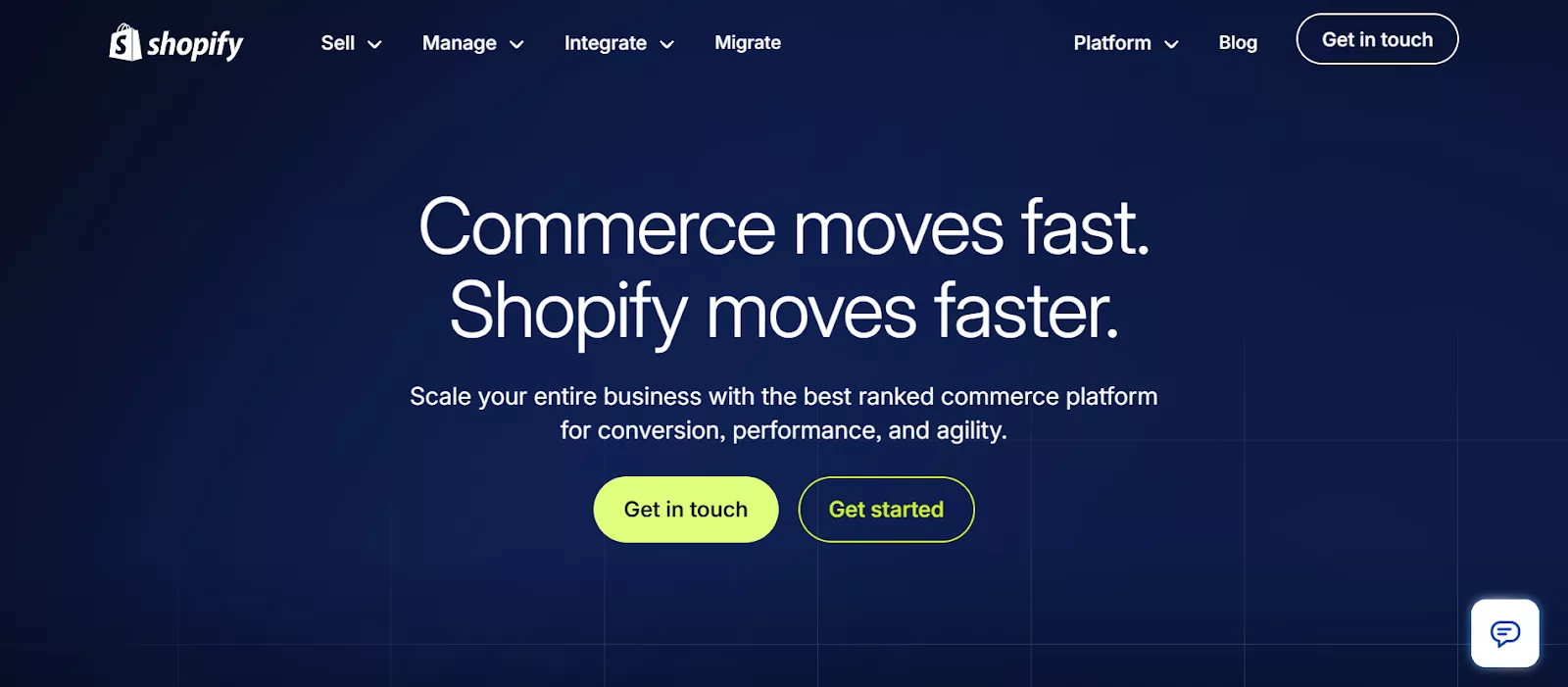
- Why it works for Healthcare: For brands selling wellness products, supplements, or over-the-counter medical devices directly to consumers, Shopify Plus is fast, reliable, and user-friendly.
- The Caveat: It requires careful planning and a dedicated HIPAA strategy to ensure compliance when dealing with sensitive data like prescription refills or patient records.
3. Sana Commerce
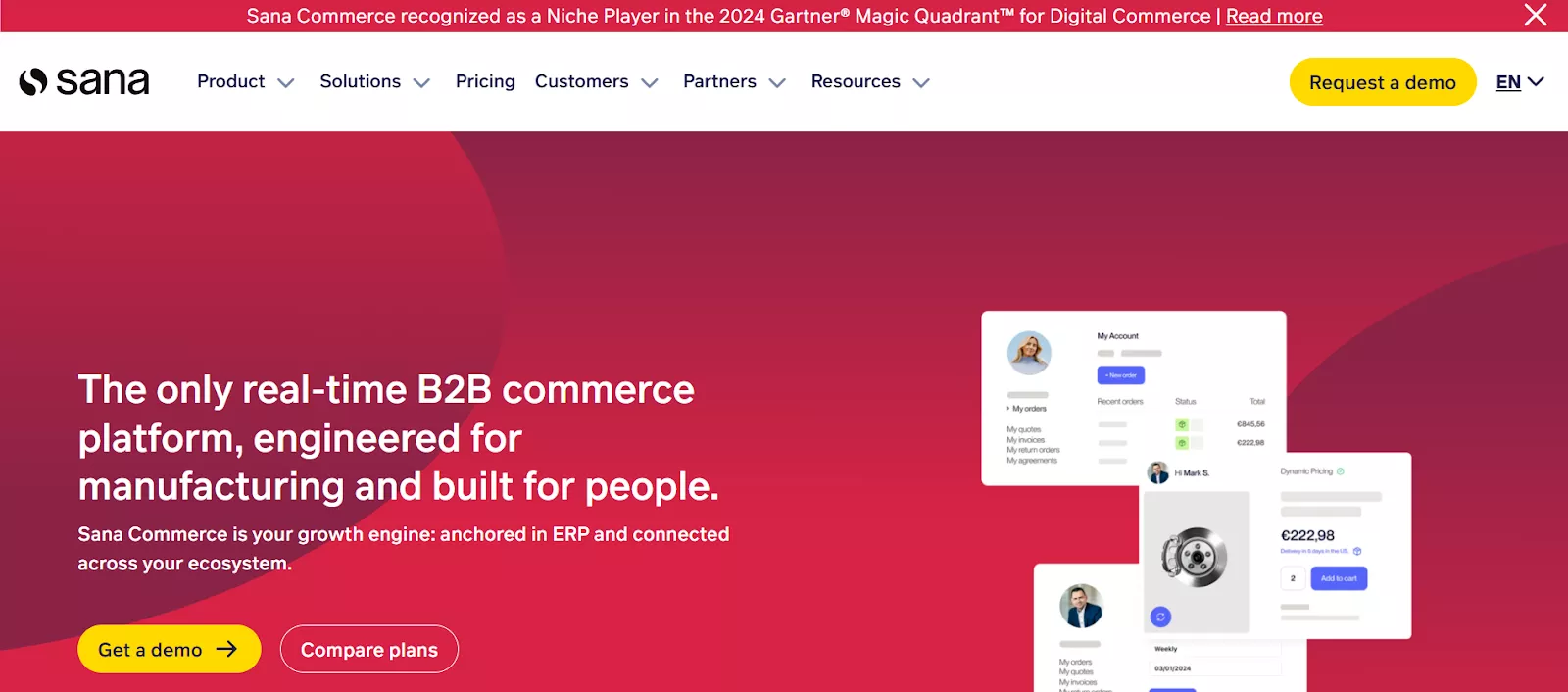
- Why it works for Healthcare: Many institutional buyers (hospitals) use huge ERP systems like SAP or Microsoft Dynamics. Sana Commerce, a B2B eCommerce platform for healthcare industry use cases, is unique because it is built to run directly on top of your existing ERP.
- The Caveat: If you aren’t heavily invested in a major ERP system already, this platform might be overkill or not the right fit.
4. BigCommerce
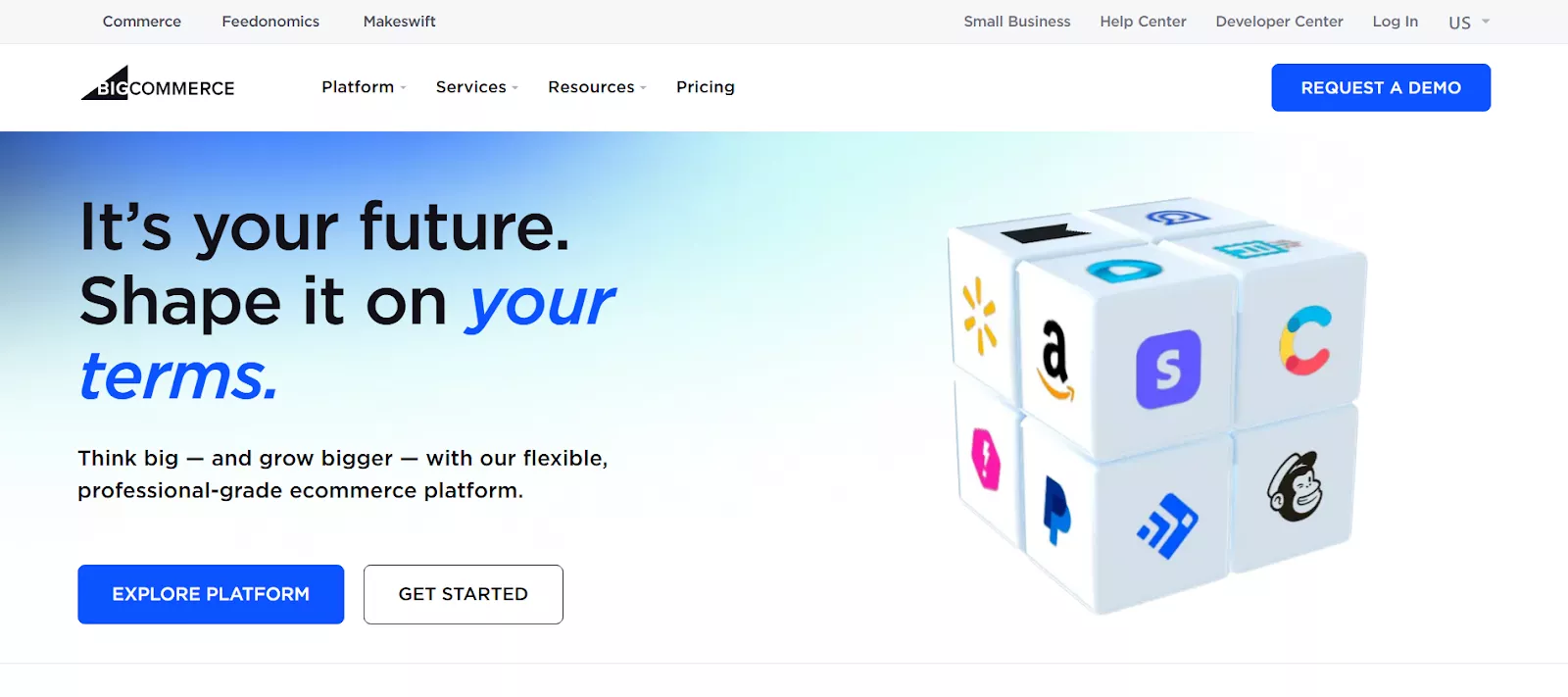
- Why it works for Healthcare: BigCommerce is often chosen for its balance of strong B2C features and growing B2B capabilities, without the huge cost of Adobe Commerce.
- The Caveat: While strong, you may still need third-party B2B apps or custom development to achieve the deep complexity of the highest-end B2B platforms.
5. commercetools (Specialized Headless Commerce)
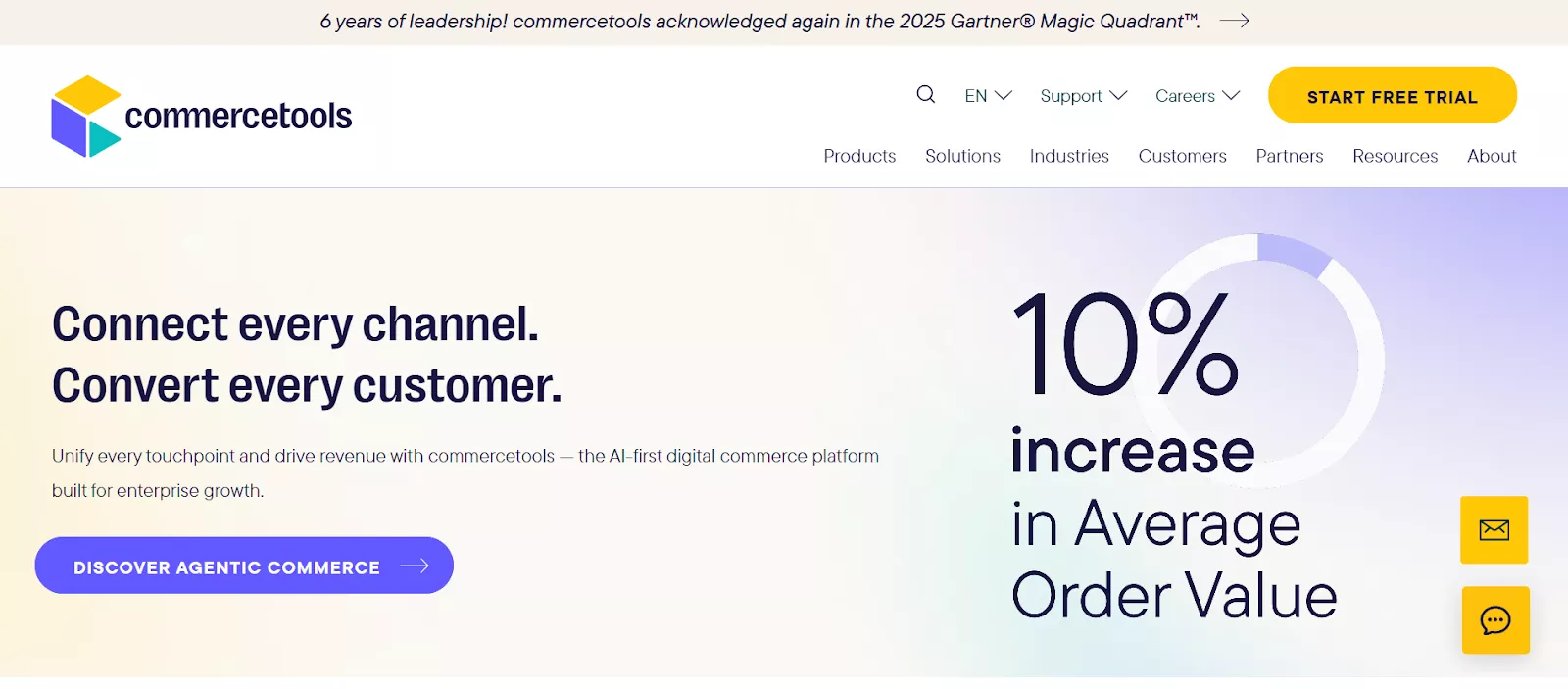
- Why it works for Healthcare: The rise of headless commerce (separating the shopper-facing frontend from the business-logic backend) is a game-changer for healthcare. Enterprise-grade platforms like commercetools and Elastic Path are often utilized for this model.
- The Caveat: This requires significant technical expertise and is best suited for complex, high-volume, or multi-regional operations.
| Platform | Best For | Key Healthcare Feature | Core Strength |
| 1. Adobe Commerce (Magento) | Large Enterprises, High-Complexity B2B | Deep ERP and PIM integrations (e.g., NetSuite) | Unmatched customization, handles complex B2B pricing models (quotes, contracts). |
| 2. Shopify Plus | B2C D2C (Direct-to-Consumer) Wellness/Med-adjacent | Vast App Store for quick feature integration | Speed, ease of use, massive ecosystem, and scalability for consumer brands. |
| 3. Sana Commerce | B2B eCommerce Healthcare Platform for ERP-Heavy Organizations (SAP/Dynamics) | Real-time, native integration with Microsoft Dynamics and SAP ERP | Uses your existing ERP as the single source of truth for pricing, inventory, and orders. |
| 4. BigCommerce | Blended B2B and B2C Models | Open SaaS model supports complex HIPAA-compliant customizations | High out-of-the-box feature set, flexible headless architecture. |
| 5. Specialized Headless Solutions (e.g., commercetools) | Highly Regulated/Global Operations | API-first design separates storefront from backend logic (PHI) | Ultimate flexibility, microservices architecture for handling strict compliance and multiple storefronts. |
How to Build a Healthcare eCommerce Application in 4 Steps
The way we shop for everything, including medical supplies, prescriptions, and wellness products, is rapidly moving to the digital space. It’s not just about setting up a basic website, though. A healthcare eCommerce solution has some unique, non-negotiable requirements.
Ready to dive in?
Let’s break down the essential steps for building an online store that’s not just successful, but also safe, compliant, and trustworthy.
Step 1: Prioritize Compliance
This is the big one. Unlike selling t-shirts or coffee mugs, healthcare deals with highly sensitive personal and medical information. Compliance is your foundation, not an afterthought.
- Know Your Regulations: In the US, you must be strictly HIPAA-compliant (Health Insurance Portability and Accountability Act). In Europe, it’s GDPR (General Data Protection Regulation). Always consult a legal expert to ensure your platform handles patient data, billing, and prescription information securely and according to local laws.
- Secure Payment Gateways: You need PCI DSS (Payment Card Industry Data Security Standard) compliant payment processing. Look for specific eCommerce solutions for healthcare that are tailored for healthcare transactions.
- Data Encryption: Everything must be encrypted, both in transit and at rest. This means using SSL/TLS certificates and robust database security.
Step 2: Choose the Right Technology Stack
Your platform needs to be robust, scalable, and easy to use for both you and your customers.
- Platform Selection: While standard platforms like Shopify or Magento can be starting points, you may need a custom or specialized platform that integrates HIPAA-compliant features out of the box. Look for systems that can handle complex inventory, prescription verification, and personalized pricing (like insurance co-pays).
- Integration is Key: Your eCommerce site needs to talk seamlessly to other systems:
▸ EHR/EMR: Electronic Health Records or Electronic Medical Records systems are crucial for verifying prescriptions and patient history.
▸ Inventory/Warehouse: To ensure you never sell something you don’t have.
▸ Logistics/Shipping: For tracking temperature-sensitive items or requiring adult signatures on delivery.
Step 3: Focus on the Customer Experience
A good user experience is what brings people back. In healthcare, this means making the typically complex process simpler.
- Virtual Consultations: Consider integrating features like live chat or video consultation with pharmacists or doctors to help customers choose the right products.
- Subscription Models: For chronic medications or recurring supplies (like diabetic test strips), an easy-to-manage subscription service is a massive convenience.
- Personalized Accounts: Patient accounts should not just store addresses, but also medication history, refill reminders, and insurance details, all secured, of course!
Step 4: Plan for Scalable Operations
Once the platform is built and secured, you need to ensure you can actually run the business effectively.
- Inventory Management: You need real-time tracking, especially for high-value or regulated items.
- Fulfillment Strategy: Are you shipping from one central warehouse, or dropping orders from multiple pharmacies? Your system must support your chosen logistics.
- Customer Support: Your support team needs training not just on the platform, but on the specific health products you sell, as customer queries will often be clinical in nature.
Building a healthcare eCommerce solution is a marathon, not a sprint. It requires meticulous planning, a strong focus on security, and a deep understanding of patient needs. Get these steps right, and you’ll be well on your way to creating a robust and valuable business!
Key Challenges and Solutions in Healthcare eCommerce
Building an online store for healthcare products or services isn’t quite the same as setting up a typical fashion or electronics shop. The stakes are higher, the regulations are tighter, and the customer base often has very specific, sensitive needs.
If you’re planning to dive into this space, you need to be aware of the unique hurdles.
Let’s talk about the big ones and how you can overcome them.
1. Security and HIPAA Compliance (or Equivalent Global Standards)
This is the absolute biggest one. You are dealing with Protected Health Information (PHI). In the US, this means strict adherence to HIPAA. Globally, you have GDPR and other regional laws. A standard eCommerce platform’s security often isn’t enough. A data breach isn’t just a headache; it’s a massive legal and financial catastrophe.
- The Problem: Storing, transmitting, and processing sensitive patient data (prescriptions, test results, medical history) securely.
- The Solution: Choose a hosting environment and a platform architecture that is specifically designed or certified for healthcare compliance. Implement end-to-end encryption. Conduct regular, rigorous security audits (penetration testing). Always separate PHI from the general shopping data whenever possible, storing it in highly-protected, isolated environments.
2. Integration with Existing Healthcare Systems
A modern healthcare solution needs to talk to the rest of the ecosystem: Electronic Health Records (EHRs), Pharmacy Management Systems, and Insurance Portals. If your platform is an island, its utility is limited.
- The Problem: EHR systems are often proprietary and notoriously difficult to integrate with. Data formats can be inconsistent.
- The Solution: Prioritize platforms that support standard healthcare data protocols like FHIR (Fast Healthcare Interoperability Resources) or HL7. Use robust API gateways to handle translations between your eCommerce platform’s data and the clinical systems’ data.
3. Ensuring Data Accuracy and Inventory Management
When someone’s health is on the line, “out of stock” or “wrong dosage” is simply unacceptable. Inventory management must be flawless and real-time.
- The Problem: Dealing with products that have short shelf lives, specific storage requirements (refrigeration), and critical stock levels.
- The Solution: Implement a sophisticated ERP (Enterprise Resource Planning) integration. This system must link your warehouse, your order management, and your website’s inventory display in real-time. For time-sensitive products, build in automated alerts for low stock or nearing expiration dates.
By addressing these three core areas head-on, you move beyond just building a website. You build a trusted digital healthcare partner, and that’s the real key to success in this vital industry.
Current Trends in Healthcare eCommerce
The healthcare eCommerce space isn’t just growing, it’s undergoing a dramatic transformation, driven by consumer demand for convenience, transparency, and personalization. The lines between retail, technology, and medical services are blurring.
Here are the major eCommerce trends in healthcare that are defining the future of buying and selling health products and services online:
1. AI and Predictive Personalization
- Artificial intelligence is being used to analyze patient data and predict what products or services a user might need. enhancing overall eCommerce personalization.
- Generative AI is also helping to automate documentation, power smart chatbots, and even assist in clinical decision-making.
2. Direct-to-Consumer (D2C) Healthcare
- More health brands are bypassing middlemen and selling directly to consumers.
- This model gives patients better access, better prices, and a more streamlined experience.
3. Telehealth and Click-to-Script
- Virtual consultations are increasingly tied to eCommerce: “click a doc, get a script, and have medicine delivered.”
- Remote monitoring and follow-up care via telemedicine are also growing.
4. Subscription Models
- Subscription-based service platforms for chronic medications, wellness products, and medical supplies are becoming more common.
- These bring convenience to users and help businesses retain customers.
5. IoT, Wearables, and Smart Health Devices
- Connected devices like fitness trackers, smart glucose monitors, and home diagnostic tools are being tied into healthcare ecommerce platforms.
- These devices help collect real-time health data, which can feed into personalized care and purchase recommendations.
6. Omnichannel & Headless Commerce
- Healthcare platforms are striving for seamless experiences across mobile apps, websites, and even physical touchpoints.
- Headless commerce architectures are being used to support this flexibility.
7. Hyper-Targeted and Precision Healthcare
- Thanks to genetic testing, diagnostics, and detailed health records, eCommerce platforms can offer more personalized, condition-specific products.
- This helps deliver not just generic care but tailored treatment and wellness plans.
These trends show that healthcare eCommerce is no longer just a niche. It’s becoming a full-fledged part of how people manage their health. If you’re building or working with a healthcare eCommerce platform, keeping an eye on these trends will help you stay ahead.
Partner with Bitcot to Build Your Custom Healthcare eCommerce Solution
If you’re ready to launch a healthcare eCommerce platform, Bitcot can help bring your idea to life. We specialize in building custom digital solutions tailored to the needs of the healthcare market, with a strong focus on usability, security, and scalability.
When you work with Bitcot, you get a partner that understands both modern eCommerce and the unique challenges of healthcare, including regulations, data privacy, and the sensitive nature of patient information.
Here’s what sets Bitcot apart:
- Custom solutions designed around your business goals: We do not force a cookie-cutter template. Every platform is built to match your audience, workflows, and market needs.
- Healthcare-grade security and compliance: We design platforms that support protected data handling and industry regulations such as HIPAA, so customers and patients can trust the system.
- Full-service development from idea to launch: Strategy, UX design, development, testing, and long-term support are all part of the process.
- Features aligned with today’s healthcare trends: From prescription uploads to subscriptions, online consultations, B2B purchasing, or inventory automation, we can build the functionality that matches your model.
- Real-world performance and scalability: Your healthcare eCommerce app will be built to grow with your business as demand and services expand.
Partnering with Bitcot means working with a team that listens, collaborates, and helps transform your vision into a practical and polished digital product.
If you’re ready to build a modern healthcare eCommerce solution that improves patient and customer experience, Bitcot is here to help make it happen.
Final Thoughts
Building a healthcare eCommerce platform is an exciting challenge.
With the right strategy and technology, you can create a solution that not only meets the needs of patients and healthcare providers but also improves access to essential products and services.
As healthcare continues to move toward digital, there’s no better time to invest in an online platform that is secure, user-friendly, and scalable.
The key is to focus on user experience, data security, and integrating the latest trends, whether that’s telehealth, subscription models, or AI-driven recommendations. And while it might feel overwhelming, the right partner can help guide you through each step.
At Bitcot, we specialize in custom healthcare software development services, offering tailored solutions that fit your unique needs. If you’re looking to build a platform that stands out in the competitive healthcare market, we’re here to help you make that vision a reality.
Ready to take the next step?
Get in touch with Bitcot today, and let’s start building your custom healthcare eCommerce solution. We’ll make sure your platform is secure, scalable, and ready to meet the demands of tomorrow’s healthcare landscape.




